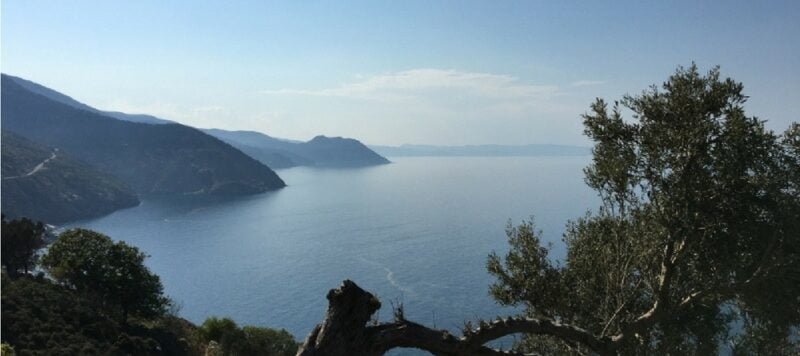In the mountains of Pelion, between sky and land and facing the sea , nature overwhelms us on all sides, and it’s a real treat. From the traditional Pelion villages of Portaria and Makrinitsa, hikes take you through a unique natural environment.
Pelion and its villages, an exceptional place
The color green dominates, it’s omnipresent, with only small patches of blue and white in the sky to remind us that we’re in Greece. The scents of nature seize you : grass humus, maple leafwood…with water trickling down the roads and a refreshing mountain breeze.
I’ve lost count of the years I’ve spent in Greece, but I’ve never been to Pelion before. But it was an unknown Greece that I discovered, much to my delight! The ancient Greeks believed that Pelion was the summer residence of the gods…now I understand better… Why ? It’s a sensory experience, a journey of well-being, relaxation and mental satisfaction through its villages and hikes.
Here are a few suggestions for walks and experiences that I’d like to share with you, along with practical advice and good addresses.
To put it simply, Pelion is a verdant mountain landscape dotted with typical villages, jutting steeply out into a sea that merges with the sky.
Let’s start with the mountains: their villages and hiking trails
The village of Portaria and its walks
Leaving Volos and the expressway, everything changes: this is Pelion. Then begin the mountain roads and the series of hairpin bends. We take our time and get to Portaria quickly. This village lives up to its name: the gates , in Greek:” Πορταριά, linked to the gate”. Indeed, in the center of the village of Portaria stands a 16th-century chapel named Panagia (Saint Mary) Portarea.

It’s a big, typical village at 650 m altitude, easy to get to. Once flourishing and prosperous(thanks to the construction of caiques and the manufacture of silks, cotton and woollen fabrics), Portaria today preserves a sizeable population thanks to trade and tourism.
The village’s picturesque character is enhanced by the opulent, traditionally-decorated houses from the last century and the village square. The main road is dotted with tourist stores selling local produce, especially fruit in syrup.
But the real attraction lies in the often cobbled streets. A stroll through Portaria’s labyrinths offers a charming landscape.
One of the ways to savour this magic and explore hidden gems of rare beauty lies in hiking, and the most famous with its mythical name is :
The centaur route
By the way, to find out where you are : MAP
From the village entrance to the church of Agia Marina, this 3 km walk takes you around Portaria. We pass churches, middle-class buildings and lush countryside. Then, at the end of the trail, a small path leads to a plateau with beautiful views. Signs point the way all along the way.
The hike from Stagiates to the village of Portaria
Easy hike, you can do the round trip too. This walk is well known for its birdwatching. You can prepare this tour on the Alltrail website, among others.
What’s more, just outside Portaria, a few kilometers away, you can visit two farms and discover their organic produce in enchanting surroundings.
Karaiskos Farm
Karaiskos Farm stands out for its magnificent location. It’s surrounded by forests of chestnut, beech and oak, fruit trees, grasses and cypresses. What’s more, you’ll delight children as they discover farm animals!
So take a stroll around the farm, pick fresh greens, herbs and vegetables from the garden, eggs from the henhouse. The Karaiskos farm also offers cooking and tasting courses on traditional Greek and Pelion recipes, next to the wood-fired oven.
Here’s the map

Koumoutsi organic farm
5 kilometers down the road from Portaria to Old Chania, you’ll find the Koumoutsi Farm sales outlet, an organic, family-run farm. Plus, there’s a fantastic signature wooden waterfall. It’s a wonderfully decorated and welcoming place. Family members will introduce you to all the farm’s products, such asextra-virgin cold-pressedolive oil, olives, apple cider vinegar and honey. They produce 10 types of exquisite honey !
Finally, many hikes start from Portaria, and you can find all the details on the following site.
The village of Makrinitza: the balcony of Pelion
This amphitheatrical village gives us a feeling of serenity and takes us back in time to Greek tradition. It nestles in lush vegetation. Makrinitza’s history is lost in the depths of the centuries. In fact, the village was probably founded in the 13th century. As soon as you enter the village, you’ll notice the magnificent buildings with their distinctive architecture.

Village highlights
First of all, access is pedestrian-only, and cars park in specially-designed parking lots at the entrance to the village. A visit to Makrinitza means a visit to :
- Carefully cobbled streets,
- Houses with typical Pelion architecture and decor;
- The square and its arcades ;
- The Byzantine Church of Ioannis Prodomos, the Byzantine Church of the Assumption of the Virgin Mary,
- The lion fountain,
- And last but not least, the Theofilos café and its famous painting,
These opulent homes with their painted decorations reflect a prosperity linked to trade and, in particular, leather tanning. They mainly date from the early 19th century. They feature slate-covered roofs and high facades decorated with painted motifs. The main street is lined with souvenir stores and the square with its century-old plane tree is very picturesque. You can’t escape the charm of theIoannis Prodomos church and its painted frescoes.
Its traditions
As for the fountain, tradition dictates that you make a wish with your back to it, so don’t hesitate – you never know!
The village comes alive during traditional Greek festivals, especially in summer when traditional weddings are staged in the village streets; but above all, during the Maides or Mays festival in July. It’s an ancestral festival dedicated to Dionysus , featuring highly expressive dancers to the rhythm of traditional Greek instruments.
Let the party begin in Makrinitsa!
Céline P.




